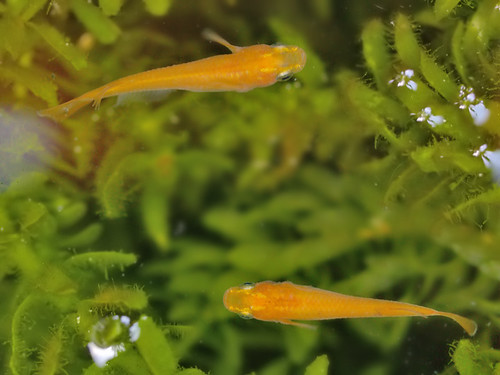As a medaka enthusiast, you're undoubtedly fascinated by the enormous variety of colors and patterns these small rice fish can possess. From deep orange to metallic blue, and from solid white to speckled patterns—the diversity is truly astonishing. But have you ever wondered how all these beautiful color variations actually come about? In this article, we delve into the fascinating world of medaka genetics and discover how new colors develop, both in the wild and in breeding. Whether you're a novice hobbyist or an experienced breeder, this article will help you better understand the genetic basis behind your favorite fish.
How are new colours created at Medaka?
New color variants at Medaka are primarily caused by mutations in DNA. A mutation is simply a change in the genetic material passed from parent to offspring. These mutations can occur spontaneously during reproduction, when a small error is made during DNA copying. While most mutations have no visible effect, some can affect the pigment cells (chromatophores) in the fish's skin, resulting in a new color or pattern variation.
In nature, this process happens relatively slowly, because only fish with colors that are advantageous for survival (e.g., good camouflage) have a greater chance of reproducing. With captive Medakas, this is different. Breeders can selectively breed fish that exhibit interesting color mutations, even though these colors might be detrimental in the wild. This is precisely how many of the spectacular color variants we know today—such as the popular Miyuki and Hikari varieties—were created and further developed.
An interesting aspect is that some new colors arise from the combination of existing genetic variants. When you cross two different color variants, the offspring can sometimes display completely new color combinations not seen in the parents. This is what makes breeding Medakas so exciting—you never know exactly what surprises the next generation will bring! Many breeders therefore keep detailed records of their crosses to identify genetic patterns.
The role of genetics in color development
A medaka's color is Determined by several types of pigment cells in its skin: melanophores (black/brown), xanthophores (yellow), erythrophores (red), leucophores (white), and iridophores (reflective/metallic). Each type of pigment cell is controlled by specific genes that determine whether the cell is present, how much pigment is produced, and how the cells are distributed throughout The body. a mutation in any of these genes can drastically affect the fish's appearance. for example, A mutation that turns off melanophores can result in a much paler or even whiter fish.
What makes it particularly interesting is that color genes can be inherited in different ways. Some traits are dominant, meaning you only need one copy of the gene to see the effect. Other traits are recessive and require both parents to inherit them. This explains why sometimes a generation has to be skipped before a particular color reappears. Medakas also have sex-linked traits, where certain colors occur only or primarily in males or females.
It's important for growers to understand that genetics aren't always predictable. besides the main Genes that determine color, there are also modifying genes that have subtle influences on the final color. environmental factors Such as water temperature, nutrition color and light can influence the expression of Color Genes. a medaka with the genetic potential for bright colors, for example, will be less intensely colored If fed suboptimal nutrition. therefore, proper care is essential to fully express the genetic beauty of your fish!
Understanding medaka genetics opens up a whole new world of possibilities for enthusiasts of these special fish. Whether you simply want to understand why your fish look the way they do, or you're looking to develop new color variations yourself, knowledge of the genetic basis is essential. Remember, the beautiful color variations we admire today are the result of years of careful selection and sometimes even lucky coincidences. If you're interested in breeding medaka, start small, keep good records, and above all, be patient. Color genetics are complex, but it's precisely that complexity that makes them so fascinating. Who knows, you might discover the next spectacular color variation that will take the medaka world by storm!



Leave a Comment
Your email address will not be published. Required fields are marked *